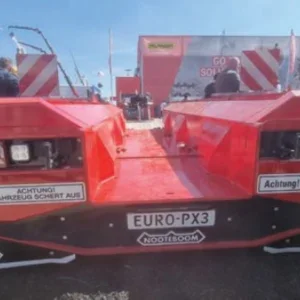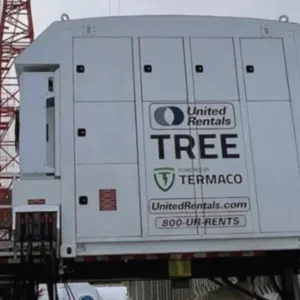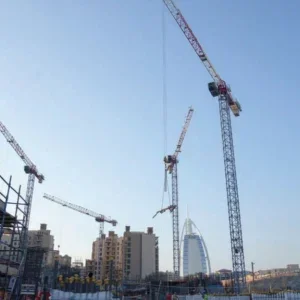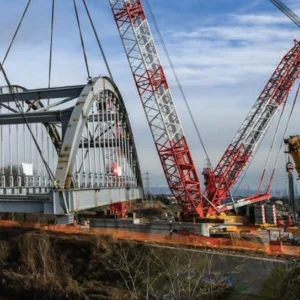At the recent Conexpo show in Las Vegas, where major manufacturers displayed their IT initiatives, it was possible to get a glimpse of the future. Distributors will go on line at any time of the day, anywhere in the world, check parts availability, place an order (having already checked the parts reference numbers on the CD-Rom manual), and take delivery the following day.
A Japanese visitor to the show said that, in his opinion, there was nothing really new among the crane products. He was not excited by the hardware, he said. It was the software exhibited inside the various exhibition booths that impressed him more. This was where the future of the industry lay. Japan, he said, was a long way behind the USA when it came to using information technology. Germany has engineering pre-eminence, Japan has led the world in efficient production, but the USA – home of Disneyland and McDonalds – has always led the way in customer service, and it is a desire to offer the best support to customers that is driving developments in this field.
Customer service and product support have always been important in the crane industry. There is no point spending a million dollars or more on a crane only to find that spare parts are not readily available, when and where they are needed. Product support can have a key bearing on the residual value of the investment. Most manufacturers recognise the value of residual value to customers. Liebherr-Werk Ehingen of Germany, for example, helps maintain the resale value of its mobile cranes by re-purchasing used cranes, reconditioning them and putting them back on the market.
A Grove sales representative will place heavy emphasis on the network that Grove has in place to service its customers, and in dissuading potential customers from buying a Terex crane, for example, will doubtless raise the subject of resale value.
That customer service is growing in importance is at least partially attributable to the battle between Grove and Terex that is being waged in the rough terrain crane market in North America. For it is here that the real volumes are traded, and here that Terex has caused most upset to the status quo ante bellum. Grove has seen its traditional dominance of this market totally eroded by the onslaught of Terex, with its “simple, available and cost effective” philosophy and “three for two” pricing strategy (“three of our cranes for the price of two of our leading competitor’s” say the advertisements in this magazine).
Grove argues that cranes cannot be regarded as commodity products in this way but the strength of the competition has forced it to remain price competitive. Management consultants from the George Group have helped cut costs at Shady Grove by reorganising production lines and the like, and a culture of continuous improvement is being embraced. Grove Worldwide president Sam Bonanno makes no secret that he is an enthusiastic follower of the Japanese concept of kaizen. But Grove knows that it cannot win the price war, not without drastic surgery for which it either sees no need or lacks the will.
Grove Crane president Jeff Bust plays down the price war: “It’s a compliment to us that Terex has to be 30% below our price to compete with us,” he says, somewhat dismissively.
Instead of trying to beat Terex on price, Grove is upping its efforts in its traditional strength of customer service and product support.
Says Bonanno: “We have strengthened our organisation and created an environment that is even more customer driven. We have raised our commitment level and mission a notch higher… We are committed to the fastest response time in the industry – quicker to respond to customer concerns; quicker to deliver parts and service; quicker to bring new products to the market. We are reducing cycle time in everything we do.” This includes new product development, the lifeblood of any manufacturer, given that the product life of an RT crane is now only about three or four years, Grove believes. It used to take Grove 24 to 36 months to get a machine to market. Outline work began on the new RT 530E in June 1998. The prototype was on show at Conexpo in March and full production begins this June – 12 months from concept to market. This has been made possible by adopting a new manufacturing approach which Grove calls integrated product development (IPD), which is a fancy way of saying that designers, manufacturers and marketeers talk to each other throughout the design and production process.
Grove’s IPD, one should note, predates last year’s arrival of the new owners and the management consultants, as does a new management information system. Hence it is not entirely clear what the management consultants from the George Group have done to deserve the $2.7m that Grove’s account show was paid to them between the change of ownership in April 1998 and the end of the financial year on 3 October. However, the George Group is a partner in the new ownership structure, so it has a certain clout at Shady Grove, and Bonanno insists that they have had some helpful ideas on the factory floor and in such areas as purchasing strategy.
One of the fruits of the “renewed focus on after sales support is Grove’s new CD-Rom parts manual for US-built crane and Manlift products. Named PartsMaster, it comes on four disks and became available in March.
Its features include broad search capabilities, by serial number, for every crane built at Shady Grove since 1975 and every Manlift built since 1982. Additional features include Windows-based operation, zoom-in parts illustrations, order accumulation, and capabilities to transfer orders to a dealer’s or customer’s business system.
Launch of PartsMaster follows closely the release of Grove’s web-based parts order and information system, Global Parts Express, or GPX, which went on-line last October. Together these products are designed to make parts ordering and delivery easier.
The solid dollar reason behind the product support drive is the firm belief that residual values are 100% dependent on product support and residual value is a key decision-making factor in purchasing a crane.
It is a logic with which Terex Lifting president Fil Filipov would like to take issue. For a start, the return from rental rates on a Terex RT is no less than a more expensive Grove. Then he will tell you: Buy my crane, I will invest the saving you make by not buying a Grove, and I will repay you the money accrued when you want to sell your crane. In other words, an over-priced crane is not the best investment you can make, he is saying.
Besides, Filipov is not convinced that there is any evidence that Terex cranes have less residual value than a Grove. Terex has not been manufacturing them long enough (only since 1995) for the resale value to have been properly established. But he knows that there is a perception across the industry that Terex does not offer good product support, a perception reinforced by Terex’s attitude to its distributors, none of whom (in mobile cranes) are given exclusive status. So although he is winning the price war, he is now responding to the customer service battle that Grove is waging. Drastic action to improve customer service and product support is now promised by Filipov (see News).
The problem with acquiring companies at the rate Terex has been doing is that indigestion can set in. Filipov, it seems, has realised that it is time to adjust his diet. Doubtless he will continue to gobble up tasty companies as they become available, but by focusing on customer service at last, he appears to be taking a step away from his ruthless commodity approach to the business: cut manufacturing costs, pile up the product and ship it out of the door. Filipov has realised, it seems, that he now needs to digest his food.
His first step, he says, is to clarify what is really a Terex problem and what is an inherited problem from having bought and saved ailing companies. To this end, he is separating the channels of support for old and current models. Current models will get the lion’s share of special attention, with products under warranty being replaced rather than repaired. “A scissor lift on a jobsite should never be repaired. It should be replaced.” Terex too is planning to offer on-line support. It has some catching up to do here, but by the end of the year or early next year there will be on-line parts ordering, warranty claims and manuals for current models, Filipov says.
It is not just Grove and Terex that are using information technology to enhance their customer service. Link-Belt and Manitowoc are also embracing IT and both are impressively advanced. A presence on the Internet may have been seen as a promotional tool a few years ago, but increasingly the potential of the web is being understood and exploited in product support and customer service.
Link-Belt’s Link-Net Pro encompasses all electronic information needed to sell or support any Link-Belt crane. It has interactive crane parts pages, technical bulletins and more than 32 volumes of service manuals. Link-Belt has set up a new department, Marketing Information Technology, to enhance and promote such technology across the distribution network. By the end of the year, the company says, an archive of nearly every crane that Link-Belt has sold in its 125 year history will be available.
Manitowoc, too, had computer terminals inside its booth at Conexpo demonstrating CD-Rom versions of its parts and service manuals, ground-bearing pressure estimator and the Compucrane lift planning software that comes as standard with Manitowoc cranes, as it does with Grove’s US-built cranes.






